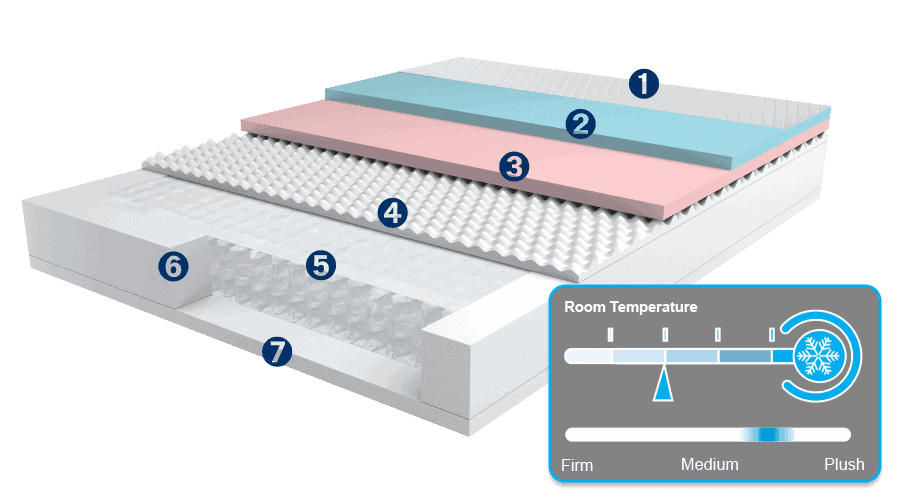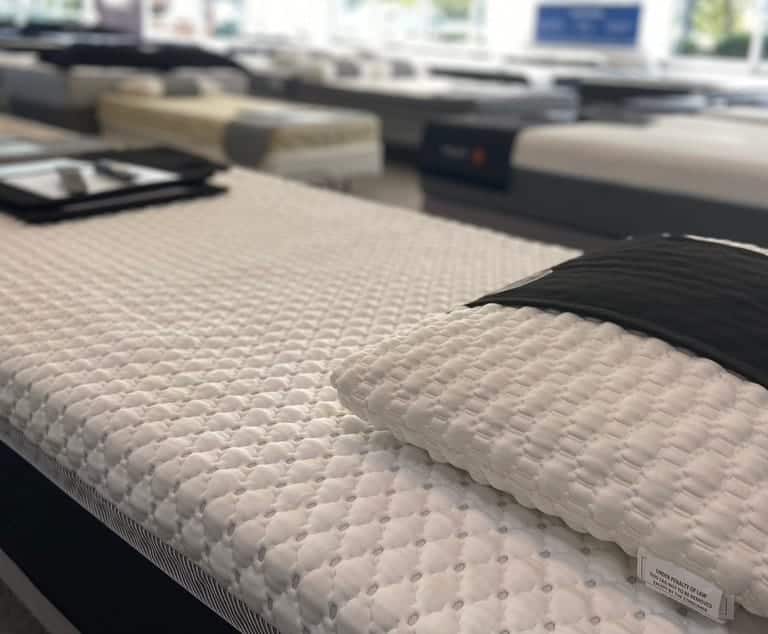What is Memory Foam? A “No Bull” Guide

Getting a good night’s sleep is important on many different levels — physically, mentally, even psychoGetting a good night’s sleep is important on many different levels — physically, mentally, even psychologically. For that reason, purchasing a new mattress, no matter the types of mattresses, is a major decision, and requires some forethought and planning.
One of the more popular mattress options on the market today is memory foam. No doubt you’ve heard the term many times before, but you may wonder: What exactly is memory foam? How does it work? What separates it from other mattress types?
In our brief but definitive guide to memory foam, we’ll answer these and other questions you may have about this innovative sleep solution..
What is Memory Foam?
Memory foam is a type of foam that mainly consists of polyurethane, combined with other chemicals that affect its viscosity and density. To be more precise, the term “memory foam” usually refers to viscoelastic foam, or foams that contain about 15-75% polyether polyol, and much less than 15% of isocyanate compounds.
Why is memory foam “viscoelastic?” A viscous material is typically thick, and only runs slowly (think of thick honey, or molasses, as an example). An elastic material is something that can be stretched or deformed, but then return to its original shape and size without any structural damage (rubber bands are a good example of this attribute). So viscoelastic memory foam is a substance that slowly changes its shape under pressure, but returns to its original shape when the pressure is released.
In addition, a rather unique feature of memory foam is its response to heat. Whereas other polyfoams may break apart or disintegrate because of temperature changes, memory foam that is heated more easily conforms to the contours of whatever weight is placed upon it.

What Types of Memory Foam Mattresses are There?
Memory foam mattresses have been around since the 1990’s, when NASA first made the underlying technology public. Nowadays, there is a wide variety of memory foam options on the market. However, most memory foam beds fall into one of three categories:
1. Traditional Memory Foam
Traditional memory foam is the material that NASA used to cushion astronauts in space. It is exceptional in its heat retention properties, which makes it a great bed for winter when body heat might not be enough. Of course, the flip side of that is how uncomfortable it can be in the middle of a heat wave due to trapping body heat.
A high-quality memory foam mattress typically has at least 4 pounds per cubic foot (PCF) of density, although it may come with a layer of low-density foam on top, to make the bed feel softer.
2. Open Cell Memory Foam
When memory foam mattresses first came out, many consumers enjoyed the support and flexibility that these products offered, but simply couldn’t take the heat associated with them during summertime. In response, companies began manufacturing open cell memory foam beds, which are designed to allow greater airflow throughout the mattress.
Open cell mattresses have basically the same look and feel as traditional memory foam beds, except they enable cooler sleep no matter your body weight. Of course, like their traditional counterparts they come in a wide range of ILD (Indentation Load Deflection) ratings.
3. Gel Memory Foam
Also known as “gel-infused memory foam,” this mattress type is also designed to make sleep on a memory foam bed cooler. In its simplest form, manufacturers mix microbeads of gel into traditional memory foam, which create spaces for greater airflow throughout the mattress. However, more complex designs enable the mattress to both store and release heat at certain temperatures — making for an extremely pleasant sleeping experience!
Not surprisingly, gel-infused memory foam beds are typically more expensive than other types of memory foam. However, they can offer significant advantages for sleepers that deal with fluctuations in body temperature during the night allowing a better comfort level.

How Much Does a Memory Foam Mattress Weigh?
The weight of a memory foam mattress depends on a number of factors, such as size, density, and type. The general weight range for a memory foam beds is between 30 and 150 lbs, with approximately 100 lbs being about average. Obviously, bigger mattresses will usually weigh more than smaller ones (for instance, a king versus a twin-size bed); and mattresses with a higher foam densities or even mattresses with more layers of foam will weigh more than low-density options.
How Does Memory Foam Compare to Other Mattress Types?
Many consumers have weighed the advantages of memory foam against those of other mattress types, and have decided that memory foam is the right choice for them. What about you? While there may be several factors in play, here are 3 key differences between memory foam mattresses and other bed types:
- Enhanced support for all sleeping positions. One of the greatest benefits of memory foam is its versatility in terms of sleeping position. If you are a back sleeper, it can help keep your spine in alignment throughout the night; and if you are a stomach or side sleeper, it can support your joints and the contours of your body without feeling too hard. In fact, many individuals that suffer from joint pain or arthritis find that memory foam helps them to sleep with minimal discomfort.
- Greater durability. Memory foam mattresses, when cared for properly, can last a long time. In fact, high quality memory foam beds can last up to 20 years! That’s a marked contrast to many spring mattresses or hybrid mattresses that have to be replaced after only 5 or 6 years at the most.
- Reduced allergy symptoms. Another exceptional benefit associated with memory foam is its resistance to common allergens, like mildew, mold, and pet dander. The construction of a typical memory foam mattress includes a dense pattern of fibers that prevents dust and allergens from accumulating within the bed.

Explore Our Memory Foam Mattresses Today
As the above information clearly demonstrates, a memory foam mattress is often the best choice for getting a good night’s sleep, no matter what season it is, or what kind of sleeper you are. If you’d like to learn more about the benefits of memory foam, or want to explore your memory foam options in more detail, then reach out to our friendly team of sleep experts today. We’d be happy to assist!
SOURCES:
https://www.explainthatstuff.com/memoryfoammattresses.html
https://www.sleepjunkie.org/how-long-do-memory-foam-mattresses-last/

FAQs
Memory foam is made of polyurethane and other chemicals that increase its viscosity and density.
Memory foam can conform to your body shape, relieve pressure points, and reduce motion transfer.
Yes, memory foam is safe to use and has been tested for harmful chemicals.
Dreaming about Getting Better Sleep?
we've got a friendly, knowledgable, passionate-about-sleep, straight-shooting, no bull sleep expert near you.


